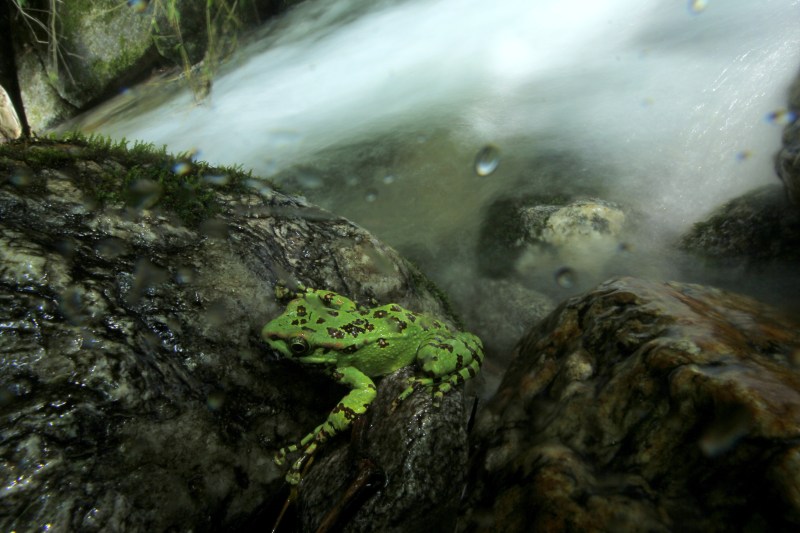Guest blog post by Henrik Bringsøe
In September 2020, we reported the first evidence for a newly discovered behaviour in snakes, as we provided extensive photographic documentation, demonstrating a macabre feeding strategy of Asian kukri snakes of the species Oligodon fasciolatus, the Small-banded Kukri Snake: a snake cutting open the abdomen of a toad, inserting its head and pulling out the toad’s organs which are then swallowed.
A Small-banded Kukri Snake attacking a Painted Burrowing Frog, which is inflating its lungs. The snake makes rotations about its own longitudinal body axis (“death rolls”), as it is biting and holding the belly of the frog. Video by Navapol Komanasin.
This is done while the toad is alive and it may take several hours before it dies! We have now provided new evidence that two other species of kukri snakes also exhibit this highly unusual behaviour: Oligodon formosanus, the Taiwanese Kukri Snake, and Oligodon ocellatus, the Ocellated Kukri Snake. These three species are closely-related and belong to the same species group in the genus Oligodon.
On two occasions in Hong Kong, a Taiwanese Kukri Snake was observed eviscerating frogs of the species Kaloula pulchra, the Painted Burrowing Frog or Banded Bullfrog. In one case, the snake had cut open the belly of the frog and inserted its head deep into the frog’s abdomen. In this position, the snake performed repeated rotations about its own longitudinal body axis, also called “death rolls”! We believe that the purpose of these death rolls was to tear out organs to be subsequently swallowed. In the other case, the organs of the frog had been forced out of its abdomen.
A Taiwanese Kukri Snake with its head buried deep into the abdomen of a Painted Burrowing Frog. Initially, the frog moves its long fourth toe of the left hind foot up and down 21 times. During the subsequent active struggle, the snake makes three “death rolls”. Video by Jonathan Rotbart.
A Small-banded Kukri Snake was also observed eating a Painted Burrowing Frog in Northeast Thailand, but it swallowed the frog whole. That snake also performed death rolls, although we have never before seen that behaviour in this species of kukri snake (this species was treated in our 2020 paper). This frog is not considered toxic and is also eaten by other snakes. We believe that prey size is crucial in determining whether the gape width allows large prey to be swallowed whole by kukri snakes. If the prey is too large, the snake may eviscerate a frog or toad, in order to swallow the organs. Afterwards, the snake will perhaps be able to swallow the rest of the frog or toad.
In another new paper, we describe and illustrate the Ocellated Kukri Snake eating the toxic toad Asian Black-spotted Toad (Duttaphrynus melanostictus) in Vietnam. Initially, the large snake’s head was buried past its eyes into the abdomen of the toad, but eventually the snake swallowed the toad whole despite its toxicity. We interpret this behaviour that kukri snakes are in fact resistant to the toads’ cardiac glycoside toxins. Furthermore, toads are only eviscerated if they prove too large to be swallowed whole.

Photo by James Holden.
We suggest that the unique behaviour of eviscerating frogs and toads and eating their organs may have evolved specifically in a group of kukri snakes named the Oligodon cyclurus group or clade because it has now been recorded in three of its species, namely Oligodon fasciolatus, Oligodon formosanus and Oligodon ocellatus. We hope that future observations may uncover additional aspects of the fascinating feeding habits of kukri snakes though we may indeed call them gruesome.
*
See more video recordings of the snakes’ unique, even if quite gruesome, behaviours provided as supplementary files to one of the discussed research papers.
*
Follow Herpetozoa on Twitter and Facebook.
*
Research papers:
Bringsøe H, Suthanthangjai M, Suthanthangjai W, Lodder J, Komanasin N (2021) Gruesome twosome kukri rippers: Oligodon formosanus (Günther, 1872) and O. fasciolatus (Günther, 1864) eat Kaloula pulchra Gray, 1831 either by eviscerating or swallowing whole. Herpetozoa 34: 49-55. https://doi.org/10.3897/herpetozoa.34.e62688
Bringsøe H, Holden J (2021) Yet another kukri snake piercing an anuran abdomen: Oligodon ocellatus (Morice, 1875) eats Duttaphrynus melanostictus (Schneider, 1799) in Vietnam. Herpetozoa 34: 57-59. https://doi.org/10.3897/herpetozoa.34.e62689

















